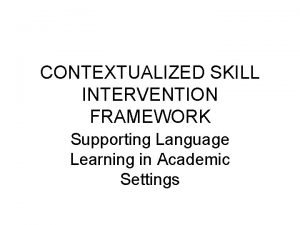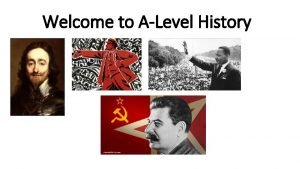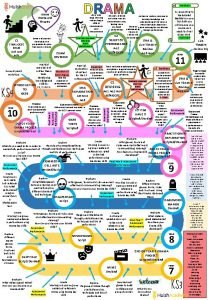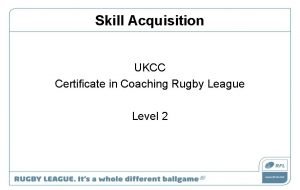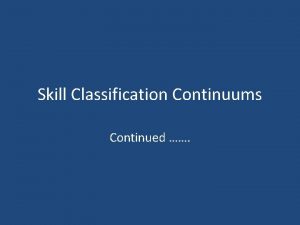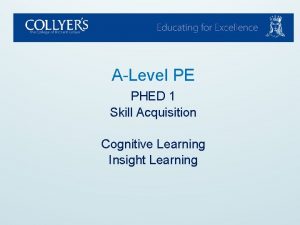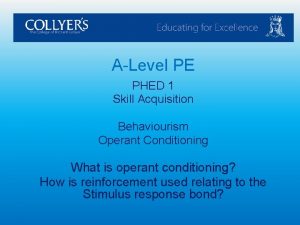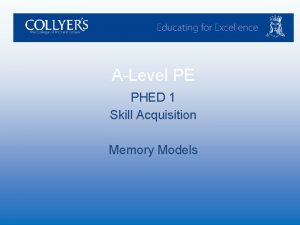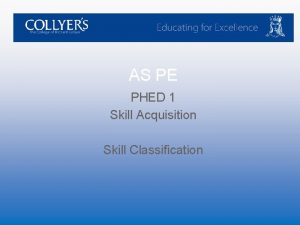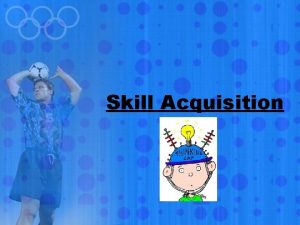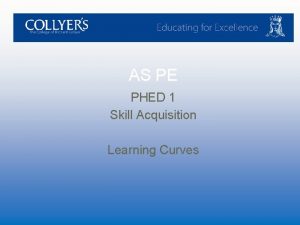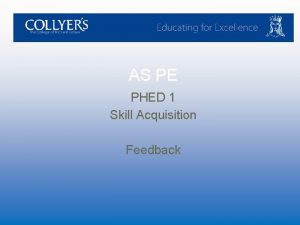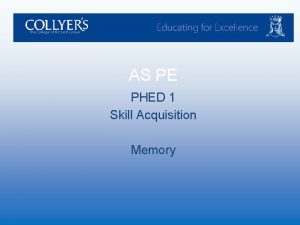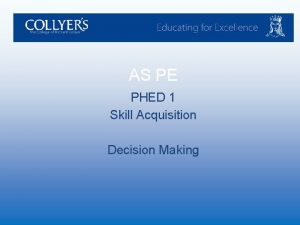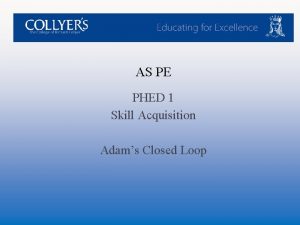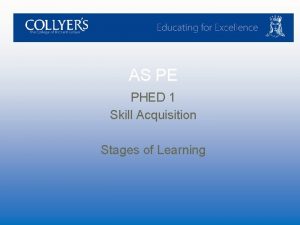ALevel PE PHED 1 Skill Acquisition Information Processing















- Slides: 15

A-Level PE PHED 1 Skill Acquisition Information Processing

Input and Selective Attention What is input data? What is selective attention? What does a model of information processing look like?

Information Processing We don’t simply do skills, we make decisions according to changing environments We need to choose. . . Which skill to perform When to perform the skill What speed to perform the skill at Simple Model of Information processing Input Decision Making Output

Input (Display and sense organs) Display is the sporting environment where all the information is gathered from Includes both relevant and irrelevant information At a Wimbledon tennis match. . . Essential information includes position of opponent, speed of ball and trajectory of ball Peripheral information includes crowd and the umpire Information is collected from the display using our sense organs Vision- Tracking the flight of a ball Hearing- Hearing the call of a team mate Touch- Weighting a pass to a team mate Kinaesthetic- knowing if action feels correct

Perception It is impossible to pay attention to all of the information which Selective you will receive attention Therefore some sorting out is necessary to avoid confusion In the Perceptual mechanisms the information picked up is filtered by Selective attention Relevant information is filtered away from the irrelevant Player is then left with only important information to concentrate on. Relevant information is coded- all subsequent decisions are made on this information alone Decision can then be made and carried out accordingly. . .

Model of information processing Decision Making Stimulus Input Response Identification Selection Programming Outp ut

Whiting’s Model of Information Processing Whiting developed a more advanced theory of information processing

Whiting’s Model of Information Processing The display/input is the sporting environment from which information is gathered. For example you see an opponent in rugby is running towards you; you feel the texture and grip of the ball in your hands; you hear the sound of their boots on the muddy ground. The receptor systems are the sense organs that detect the environmental stimuli, for example the eyes / vision, ears / audition, touch / tactile and proprioceptor / kinesthesis. The rugby example above involves visual, tactile and auditory senses

Whiting’s Model of Information Processing The perceptual mechanisms involve detection of the stimuli through the receptor systems. The information received is then compared to information stored in the long term memory and recognition of the stimuli. For example, you detect, compare and recognise the size of the opponent heading towards you. Known as the DCR Process. Selective attention is used to filter relevant information from irrelevant information. For example, while seeing the opponent you may also be hearing sounds from the crowd and other players. You need to focus on the opponent rather than the other,

Whiting’s Model of Information Processing The translatory mechanism uses the information gathered from the environment, adapts the information, compares it to information stored in long term memory, and then finally, makes the appropriate decision. For example you recognise that the opponent is going to tackle you so, comparing to previous experiences, you decide to pass the ball as this has previously had a positive outcome. The receptor systems, perceptual and translatory mechanisms are known as central mechanisms as these are involved in the decision-making process.

Whiting’s Model of Information Processing The effector mechanism transfers the decision that has been made to pass to the muscular system via motor nerves. The muscular system involves the body producing the response and movement. For example, you execute the pass to a teammate. Output Data is information about the skill being produced. For example you see the pass travelling towards your teammate who successfully catches the ball. Feedback data is information used to amend performance. Feedback occurs both during and after movements and directs future movement. For

Task Watch Usain Bolt’s 100 m world record run https: //www. youtube. com/watch? v=By 1 JQFxf. LMM Use Whiting’s model to explain how Usain Bolt reacts to the start gun and starts his race.

Group Task – Apply Whiting’s model to the following sporting actions Group 1 – A footballer playing a lofted pass Group 2 – A Rugby player making a tackle Group 3 – A Gymnast timing their jump over the vault Group 4 – A Swimmer timing a tumble turn Extension – A goalkeeper makes a save, a javelin throw, a darts throw, 10, 000 m runner makes a sprint finish.

Exam Question Outline Whiting’s model of information processing and explain how the perceptual mechanism can affect the performance of physical activities. (6 marks) 10 mins – GO!!!!

Mark Scheme Components – Sub max 3 marks for 6 identified; 2 marks for 4 identified; 1 mark for 2 identified A. Environment B. Input data or display C. Sense or sensory organs / receptor systems D. Body boundary / Central mechanism E. Perceptual mechanism(s) F. Translatory mechanism(s) G. Effector mechanisms H. Muscular system. I. Output / output data / response J. Feedback Good perception enhances performance because performer able to (accept opposites for bad perception throughout) : K. Make sense of or judge or interpret information / understand what they need to do / Detect, Compare and Recognise / DCR process L. Selectively attend / concentrate / focus on relevant information / select or filter information / ignore irrelevant information / detect appropriate stimuli M. See the same thing (as others) but in a different way / make individual or different meaning from same stimuli / perform differently because of different perceptions / be more creative (than others) / react more quickly N. Use memory – the more experiences they have the more information they can draw on O. Use motor programmes (from LTM) / recognise appropriate movement patterns P. Uses schema to refine or inform processing (to make performance effective)
 Phed phed rosebery
Phed phed rosebery Edexcel alevel history
Edexcel alevel history Aqa data sheet
Aqa data sheet Drama alevel
Drama alevel Aqa alevel psychology
Aqa alevel psychology Language acquisition vs language learning
Language acquisition vs language learning Rfl coaching courses
Rfl coaching courses Open closed continuum
Open closed continuum Skills
Skills Defense acquisition management information retrieval
Defense acquisition management information retrieval Bottom up processing
Bottom up processing Bottom up processing vs top down processing
Bottom up processing vs top down processing Bottom up processing
Bottom up processing Neighborhood processing in image processing
Neighborhood processing in image processing Secondary processing
Secondary processing Point processing in image processing
Point processing in image processing
